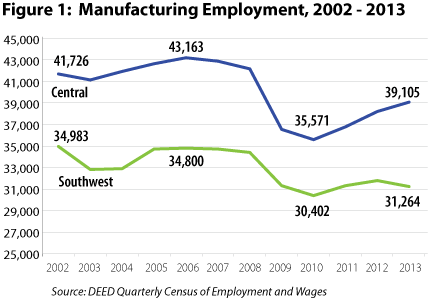
by Luke Greiner
June 2014
Manufacturing is a major employer in southwestern and central Minnesota, accounting for more than 70,000 jobs.
Anyone walking into a manufacturing plant today would see a stark contrast from what was common in the last century. Much progress has been made toward correcting safety and health concerns of yesteryear and promoting a vibrant workplace. One thing hasn't changed, though. The industry remains an important source of jobs, both nationally and in Minnesota.
Central and southwestern Minnesota are home to a variety of manufacturers, from food processing manufactures like Seneca Foods and Jennie-O, to specialized vehicle manufacturers like Polar Tank Corp. and agricultural equipment makers like AGCO.
These and other manufacturers have a major impact on local economies in central and southwestern Minnesota, providing more than 70,000 jobs in the region.
As Table 1 illustrates, southwestern Minnesota has the highest concentration of manufacturing jobs in the state with a location quotient of 2.0. A location quotient (LQ) is a way of showing how concentrated a particular industry is compared with the country or state. The value 2.0 means that southwestern Minnesota has two times more manufacturing jobs than the country as a whole.
Central Minnesota also has a high location quotient at 1.69. So while the Twin Cities metro employs many more people in manufacturing, the concentration of manufacturing jobs is actually greater in southwestern and central Minnesota.
A higher LQ demonstrates the importance of a particular industry in a region. Just over 16 percent of all jobs in the combined central and southwestern regions are in manufacturing, with the southwest at 18.1 percent and central at 15.2 percent. The percentage of jobs in manufacturing statewide is 11.5 percent and nationally 10.5 percent.
| Manufacturing Industry, Average of Qtrs. 1-3, 2013 | |||
|---|---|---|---|
| Planning Area | Employment | Establishments | Location Quotient |
| Central Minnesota | 39,105 | 1,160 | 1.69 |
| Northeast Minnesota | 8,941 | 359 | 0.71 |
| Northwest Minnesota | 27,885 | 841 | 1.45 |
| Twin Cities Metro | 162,571 | 4,100 | 1.12 |
| Southeast Minnesota | 36,653 | 668 | 1.74 |
| Southwest Minnesota | 31,264 | 610 | 2.00 |
| Source: DEED Quarterly Census of Employment and Wages | |||
Manufacturing is notorious for being affected by business cycles, and the most recent recession was no exception. While manufacturing employment is making a steady recovery in central and southwestern Minnesota, it remains below pre-recession levels.
In the four years leading up to the start of the recession, manufacturing employment averaged 42,647 jobs in central Minnesota and 34,275 jobs in the southwest. In the four years following the recession, that numbers dropped to 37,427 in central and 31,202 in southwest.
The good news is that manufacturing employment has been steadily growing since the end of the recession (see Figure 1). It's easy to recognize not only the impact of the recession on manufacturing but also the differences in the recovery in each area. Except for a slight dip in the southwest in 2013, employment in the sector has been making steady progress.

The central region was hit harder during the recession, with manufacturing employment plummeting over 17 percent, compared with a 12 percent loss in the southwest. From 2010 through the first three quarters of 2013, employment in the sector grew almost 10 percent in central and almost 3 percent in southwest. That well outpaced overall employment growth, which was 4.7 percent in the central region and 1.2 percent in the southwest.
Manufacturing has added 3,534 jobs in central and 862 jobs in the southwest since 2010. Over the same period manufacturing employment grew 5 percent statewide. Despite slightly different trends during and after the recession, both areas currently stand at over 85% percent of their pre-recession peak employment in the sector.
The largest sector within manufacturing for both regions is food manufacturing. With 17,369 jobs, food manufacturing represents 25 percent of the manufacturing sector in the combined areas. Food manufacturing is even more concentrated in southwestern Minnesota, with just over 10,000 jobs (32 percent of all manufacturing jobs in the region). Food production is also the largest manufacturing subsector in central Minnesota, averaging 7,467 workers for the first three quarters of 2013.
Other differences appear more pronounced when looking at the two areas from 2012 to 2013. Table 2 shows that central Minnesota gained 873 manufacturing jobs, while southwest lost 550 during that period. While a loss of 550 jobs is not insignificant, it's important to keep in mind that it represents less than 2 percent of Southwest's manufacturing jobs.
Food manufacturing saw the largest gains in central Minnesota over the one-year period, adding 286 jobs. Printing and fabricated metal both gained more than 150 jobs. Gains in southwest were in a few other areas, with the largest being in machinery manufacturing, which added 168 jobs. Transportation equipment, nonmetallic mineral and beverage manufacturing also added jobs.
| Manufacturing Employment Gains and Losses by Sector, 2012 - 2013 | ||
|---|---|---|
| Sectors within the Manufacturing Industry | Central 2012 - 2013 change | Southwest 2012 - 2013 change |
| Manufacturing | 873 | -550 |
| Food Manufacturing | 286 | -228 |
| Beverage and Tobacco Product Manufacturing | 78 | 35 |
| Textile Product Mills | 29 | No Data |
| Apparel Manufacturing | -37 | No Data |
| Wood Product Manufacturing | 41 | -11 |
| Paper Manufacturing | -145 | No Data |
| Printing and Related Support Activities | 197 | -79 |
| Chemical Manufacturing | -85 | -49 |
| Plastics and Rubber Products Manufacturing | 93 | -91 |
| Nonmetallic Mineral Product Manufacturing | 79 | 44 |
| Fabricated Metal Product Manufacturing | 177 | 16 |
| Machinery Manufacturing | 16 | 168 |
| Computer and Electronic Product Manufacturing | 2 | -245 |
| Electrical Equipment, Appliance, and Component Mfg. | -111 | -5 |
| Source: DEED Quarterly Census of Employment and Wages | ||
Manufacturing offers a wide variety of occupations beyond production. Many of these jobs provide wages that are considerably above the median for all occupations. While Johnny Paycheck sang "Take This Job and Shove It" about factory work, his advice might be reconsidered after looking at the data.
Holding on to the factory job might be better advice for today. The average weekly wage in manufacturing is about 25 percent more than the average for all occupations, or $172 more per week in central and $161 per week in southwestern Minnesota.
Some of the most common occupations in manufacturing include production, transportation and material moving, office and administrative support, installation and repair, as well as management, sales and business, and financial operations (see Table 3). With the exception of transportation and material moving in central Minnesota, all the occupations in Table 3 have significantly higher hourly wages than the median hourly wage for occupations across all industries.
Source: DEED Occupational Employment Statistics| 2013 Common Manufacturing Occupations | |||||
|---|---|---|---|---|---|
| All Industries and Occupations | Central Minnesota | Southwest Minnesota | |||
| Employment | Median Wage | Employment | Median Wage | ||
| Manufacturing Industry | Management | 2,170 | $44.41 | 1,480 | $43.25 |
| Business and Financial Operations | 1,310 | $27.01 | 1,080 | $26.61 | |
| Sales and Related | 1,300 | $26.15 | 910 | $22.71 | |
| Office and Administrative Support | 4,070 | $16.60 | 3,010 | $16.12 | |
| Installation, Maintenance and Repair | 2,210 | $21.50 | 1,960 | $20.69 | |
| Production | 24,230 | $16.09 | 21,400 | $14.93 | |
| Transportation and Material Moving | 3,420 | $15.00 | 3,820 | $15.15 | |
Manufacturing allows employees at all levels to see firsthand a tangible product that has been made - the definition of accomplishment to many workers. It provides the satisfaction of being part of a process that can take raw material and transform it into a necessity, a life saver, a luxury or something truly incredible. Whether producing a trailer, conveyor or tape, manufacturing in central and southwestern Minnesota is a way of life for many residents and will continue to be as long as there is a demand for high-quality products.